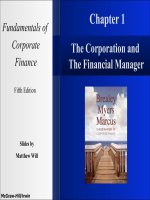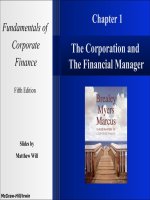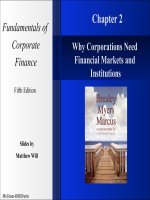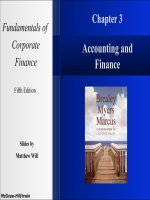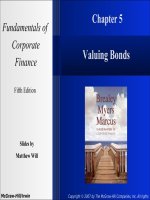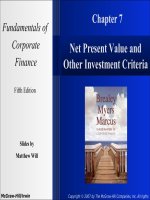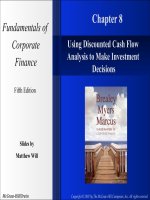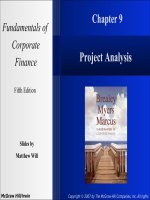Fundamentals of corporate finance 5e mcgraw chapter 03
Bạn đang xem bản rút gọn của tài liệu. Xem và tải ngay bản đầy đủ của tài liệu tại đây (994.12 KB, 21 trang )
Fundamentals of
Corporate
Finance
Fifth Edition
Slides by
Matthew Will
McGraw-Hill/Irwin
Chapter 3
Accounting and
Finance
3- 2
Topics Covered
The Balance Sheet
The Income Statement
The Statement of Cash Flows
Accounting Practice & Malpractice
Taxes
McGraw-Hill/Irwin
Copyright © 2007 by The McGraw-Hill Companies, Inc. All rights
3- 3
The Balance Sheet
Definition
Financial statements that show
the value of the firm’s assets
and liabilities at a particular
point in time (from an
accounting perspective).
McGraw-Hill/Irwin
Copyright © 2007 by The McGraw-Hill Companies, Inc. All rights
3- 4
The Balance Sheet
}{
The Main Balance Sheet Items
Current Assets
Cash & Securities
Receivables
Inventories
+
=
Fixed Assets
Tangible Assets
Intangible Assets
McGraw-Hill/Irwin
Current Liabilities
Payables
Short-term Debt
+
Long-term Liabilities
+
Shareholders’ Equity
Copyright © 2007 by The McGraw-Hill Companies, Inc. All rights
3- 5
Market Value vs. Book Value
Book Values are determined by GAAP
Market Values are determined by current values
Equity and Asset “Market Values” are usually
higher than their “Book Values”
McGraw-Hill/Irwin
Copyright © 2007 by The McGraw-Hill Companies, Inc. All rights
3- 6
Market Value vs. Book Value
Example
According to GAAP, your firm has equity worth $6
billion, debt worth $4 billion, assets worth $10
billion. The market values your firm’s 100 million
shares at $75 per share and the debt at $4 billion.
Q: What is the market value of your assets?
A: Since (Assets=Liabilities + Equity), your assets
must have a market value of $11.5 billion.
McGraw-Hill/Irwin
Copyright © 2007 by The McGraw-Hill Companies, Inc. All rights
3- 7
Market Value vs. Book Value
Example (continued)
Book Value Balance Sheet
Assets = $10 bil
Debt = $4 bil
Equity = $6 bil
Market Value Balance Sheet
Assets = $11.5 bil
Debt = $4 bil
Equity = $7.5 bil
McGraw-Hill/Irwin
Copyright © 2007 by The McGraw-Hill Companies, Inc. All rights
3- 8
The Income Statement
Definition
Financial statement that shows the
revenues, expenses, and net income
of a firm over a period of time (from
an accounting perspective).
McGraw-Hill/Irwin
Copyright © 2007 by The McGraw-Hill Companies, Inc. All rights
3- 9
The Income Statement
Earnings Before Income & Taxes (EBIT)
EBIT =
McGraw-Hill/Irwin
- total Revenues
- costs
- deprecation
Copyright © 2007 by The McGraw-Hill Companies, Inc. All rights
3- 10
The Income Statement
Pepsico Income Statement (year end 2004)
Net Sales
COGS
Selling, G&A expenses
Depreciation expense
EBIT
Net interest expense
Taxable Income
Income Taxes
Net Income
McGraw-Hill/Irwin
29,261
12,142
10,142
1,264
5,713
167
5,546
1,334
4,212
Copyright © 2007 by The McGraw-Hill Companies, Inc. All rights
3- 11
Profits vs. Cash Flows
Differences
“Profits” subtract depreciation (a non-cash
expense)
“Profits” ignore cash expenditures on new capital
(the expense is capitalized)
“Profits” record income and expenses at the time of
sales, not when the cash exchanges actually occur
“Profits” do not consider changes in working
capital
McGraw-Hill/Irwin
Copyright © 2007 by The McGraw-Hill Companies, Inc. All rights
3- 12
The Statement of Cash Flows
Definition
Financial statement that shows the
firm’s cash receipts and cash
payments over a period of time.
McGraw-Hill/Irwin
Copyright © 2007 by The McGraw-Hill Companies, Inc. All rights
3- 13
The Statement of Cash Flows
Pepsico Statement of Cash Flows (excerpt - year end 2004)
Net Income 4,212
Non-cash expenses
Depreciation
1,264
Other
(109)
Changes in working capital
A/R=(130) A/P=(50) Inv=(100) other=(33)
(313)
Cash Flow from operations 5,054
Cash Flow from investments
(2,330)
Cash provided by financing
(2,264)
Net Change in Cash Position
460
McGraw-Hill/Irwin
Copyright © 2007 by The McGraw-Hill Companies, Inc. All rights
3- 14
Accounting Practice
Stock options
Cookie Jar Reserves
Off balance sheet assets and liabilities
Revenue recognition
McGraw-Hill/Irwin
Copyright © 2007 by The McGraw-Hill Companies, Inc. All rights
3- 15
Taxes
Taxes have a major impact on financial
decisions
Marginal Tax Rate is the tax that the individual
pays on each extra dollar of income.
Average Tax Rate is the total tax bill divided by
total income.
McGraw-Hill/Irwin
Copyright © 2007 by The McGraw-Hill Companies, Inc. All rights
3- 16
Taxes
Example -- Taxes
Example
Taxesand
andCash
CashFlows
Flowscan
canbebechanged
changedby
by the
the
useuse
of debt.
of debt.
Firm
Firm
A pays
A pays
partpart
of itsofprofits
its profits
as
as debt
debt
interest.
interest.
Firm
Firm
B does
B does
not.not.
EBIT
EBIT
Interest
Interest
Pretax Income
Pretax
Income
Taxes (35%)
Net Income
McGraw-Hill/Irwin
Firm A
A
100
40
60
21
21
39
Firm B
100
0
100
35
65
Copyright © 2007 by The McGraw-Hill Companies, Inc. All rights
3- 17
Taxes
FOOD FOR THOUGHT - If you were both the debt
and equity holders of the firm, which would
generate more cash flow to you? (assume Net
Income = Cash Flow)
Firm A
Firm B
EBIT
100
100
Interest
40
0
Pretax Income
60
100
Taxes (35%)
21
35
Net Income
39
65
?
McGraw-Hill/Irwin
Copyright © 2007 by The McGraw-Hill Companies, Inc. All rights
3- 18
Taxes
FOOD FOR THOUGHT - If you were both the debt
and equity holders of the firm, which would
generate more cash flow to you? (assume Net
Income = Cash Flow)
Firm A
Firm B
Net Income
39
65
+ Interest
40
0
Net Cash Flow
79
65
?
McGraw-Hill/Irwin
Copyright © 2007 by The McGraw-Hill Companies, Inc. All rights
3- 19
Corporate Tax Rates (2005)
Taxable Income ($)
0-50,000
50,001-75,000
75,001-100,000
100,001-18,333,333
over 18,333,333
McGraw-Hill/Irwin
Tax Rate (%)
15
25
34
34-39
35
Copyright © 2007 by The McGraw-Hill Companies, Inc. All rights
3- 20
Personal Tax Rates (2005)
McGraw-Hill/Irwin
Copyright © 2007 by The McGraw-Hill Companies, Inc. All rights
3- 21
IRS Web Site
McGraw-Hill/Irwin
Copyright © 2007 by The McGraw-Hill Companies, Inc. All rights
